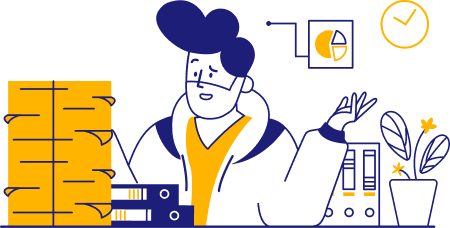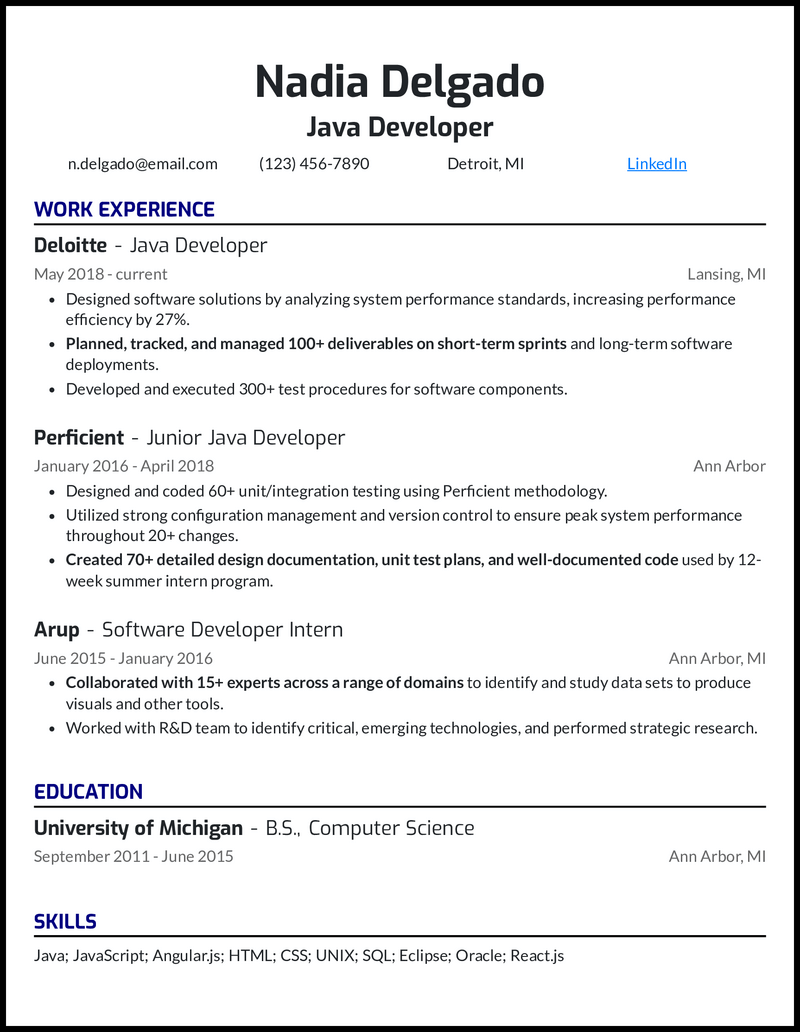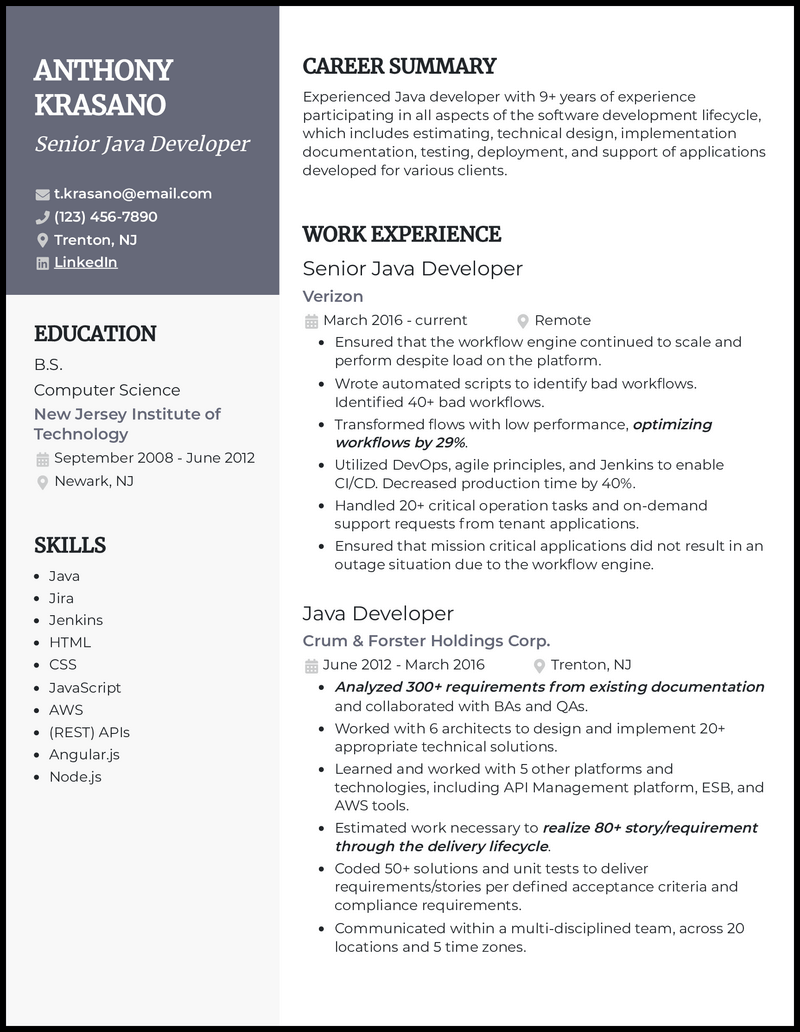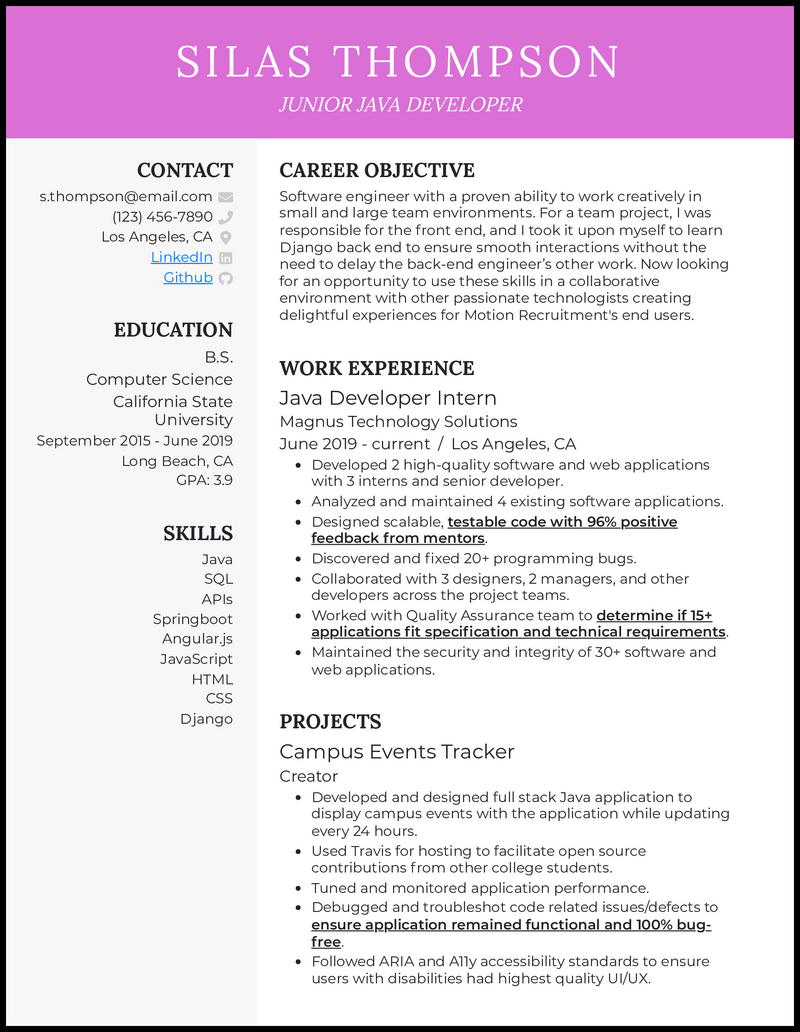The hardest part of building your Java developer resume and creating a cover letter is looking at a blank page. We looked at numerous Java developer resumes for different career stages and specialties and chose the best five to help you get started.
These nine Java developer resume examples have helped Java devs land jobs at companies like JP Morgan and Stripe, so they’re proven to work and a great way for you to get started creating or updating your resume in 2024.
Why this resume works
- When building your Java developer resume, it’s important to keep your goal in mind: to quickly make the case to the hiring manager that you deserve an interview. The best way to make this case is to use numbers to describe your accomplishments.
- It’s better to focus on your accomplishments instead of responsibilities on your resume. Achievements can naturally be described using metrics.
- The impact of your work can be very rough estimates. You want to show that you know which metrics matter to the business. These metrics are usually customer-facing. Revenue, user growth, and efficiency improvements are all examples of metrics on which you can focus.
- If you have less than five years of experience, you should strive to keep your resume to one page. As such, only include a resume objective if you think it will convey new information about your qualifications for the kind of job for which you’re looking.
Why this resume works
- The more senior you become in your career as a Java developer, the more important it becomes to demonstrate you’ve taken on more responsibility throughout your career. A great way to do this is to show ownership over projects. You can do this with action verbs like “led,” “owned,” and “managed.”
- If you managed other, more junior developers, be sure to dedicate a bullet point on your resume to that!
- Your web developer skills need to strike the right balance between being an exhaustive laundry list and completely missing the languages or frameworks with which you’re experienced.
- It’s a big red flag for a technical hiring manager to see a programmer who claims knowledge of 10+ programming languages on their resume. It’s much better to be an expert of one or two than claim knowledge of so many.
- When determining which Java frameworks to include on your senior Java developer resume, read the job description of the role for which you’re applying.
Why this resume works
- Getting your first full-time Java developer role can be challenging and discouraging at times. Don’t worry; remember, everyone started as a junior Java developer at some point!
- In your junior Java developer resume, consider adding a resume objective to give employers a brief (two to three sentences) yet engaging snapshot of your personality and capabilities.
- Career objectives are only useful when they’re customized. This means you should tailor them to each position you apply to (use the job description for keywords) and mention the company by name.
- The key as a junior dev is to convince the hiring manager that you can meaningfully contribute to their company. You can do this through your experience with projects.
- Did you build something cool as part of a class? Do something to scratch your own itch? Have success at a hackathon? The more project work on your junior Java developer resume, the better.
- At this point, hiring managers know your resume won’t be comprehensive. Just include relevant projects and any internships to showcase your knowledge.
Why this resume works
- When you’re trying to demonstrate your specific experience when first starting out, you need to show the precise context in which you used the skills listed on your resume.
- More than that, you should show how you used that language/framework to impact the business meaningfully. The more metrics, the more convincing your resume becomes.
- Have the primary job title on your entry-level Java developer resume (right under the name in this resume) exactly match the role you’re applying to as a developer. Also, include your experience with development in your resume objective (if you decide to include one, which you don’t need to do). If you’re light on or have no experience, you might list relevant projects, activities, or hobbies that show employers your interest and initiative in the field.
Why this resume works
- Showcasing your familiarity with relevant tools and technologies on your Java UI developer resume marks you out as an invaluable asset in an industry that continually evolves. Think along the lines of software programs and frameworks like JavaFX, Dropwizard, Angular, and Apache Maven.
- Showing knowledge and former application of such technologies doesn’t just demonstrate your tech-savviness but also provides a practical overview of the tasks and projects you’re capable of handling. Won’t that instill confidence in the potential employer about your suitability for their team?
Why this resume works
- Before you click the submit button, take a moment to rethink your Java AWS resume’s structure—it’s as important, regardless of how persuasive your arguments can be. Add a section for your academic qualifications, certifications, and skills that make sense for the role.
- Your previous job experiences deserve maximum visibility on your resume; organize them in bullet points for readability (starting from the most recent), detailing your role, responsibilities, tools used, and quantified achievements.
Why this resume works
- A backend developer keeps systems running smoothly from behind the scenes—which is no small feat.
- Holding a notoriously challenging certification like Oracle’s Java SE 11 is well worth including on your Java backend developer resume to prove you know your stuff.
Why this resume works
- Java developers are the minds behind some of today’s most popular apps.
- If you have experience designing the user interface on a widely-used platform—like Lyft or Netflix—place those positions prominently on your Agile Java developer resume to quickly gain recognition from recruiters.
Why this resume works
- When you’re applying for a specialized role, make sure the title on your full-stack Java developer resume (below your name) matches the job title of the role found in the business job description.
- When applying to a Java full-stack role, it may not come as a big surprise that you should zoom in on your experience with Java in your previous positions.
- Discuss any frameworks you’ve used (like Spring) and the scope of the projects in which you used Java. This is the time to put some context around your Java experience.
- If you happen to be a little light on your work history, you can fill up any white space with internships or relevant projects you’ve worked on—they can effectively demonstrate your skill, initiative, and passion, in lieu of paid work.
Related resume guides
Writing Your Java Developer Resume

A nice, clean resume is perhaps the best way to present yourself professionally. Your resume’s format can be a great way to convey your professional image, ensuring your Java developer resume is readable, logical, and complete. This article will guide you through the basics of resume formatting. We’ll cover the following topics:
- Reverse-chronological format, functional format, and combination/hybrid format
- Including the right contact info
- Beating the ATS

Reverse-chronological format, functional format, and combination/hybrid format
The most popular formats in 2024 are reverse-chronological, functional, and combination/hybrid. Online tools like our resume formatting guide can help you format your resume in minutes, but it’s still worth understanding the basics.
- The most popular formats in 2024 are reverse-chronological, functional, and combination/hybrid. Online tools like our resume formatting guide can help you format your resume in minutes, but it’s still worth understanding the basics.
- Using the reverse-chronological format, your most recent, relevant position would be at the top of your resume, with previous work following in reverse-chronological order.
- Using functional format, list your skills first. Then include employment history arranged by job function (e.g., sales manager).
- Next, you would add education, followed by other information in any order you choose. Employ a functional format when you’re trying to change career paths.
- To implement a combination or hybrid of functional and reverse-chronological format, skills and work history are equally balanced. List skills after contact information, but emphasize work history, as well.
- The reverse-chronological format is the best choice for a Java developer resume because it ensures that recruiters can see your most recent work history first in an easy-to-read timeline

Including the right contact info
Contact information is an essential part of your resume. Include a logical flow of information that will help recruiters reach you easily. Our resume examples can teach you what you need to know! Contact information should be located near the top of your resume. Your Java developer resume should include:
- Your name and job title you’re seeking
- Phone and email
- City and state are optional
- Social media links are optional but can help the employer discover more about you if needed

Beat the ATS
Applicant Tracking Systems (ATS) scan resumes for keywords related to the job description, so it’s important to format your Java developer resume with keywords in mind. ATS scans for patterns and analyzes the content of the resume. If your resume lacks keywords or is formatted improperly, you may be automatically filtered from the applicant pool.
Essential tips to getting past the ATS:
- Margins: The role of margins in formatting your Java developer resume is to ensure the text looks neat and clean. Place one extra line between each paragraph for better readability. The top, bottom, and side margins are typically 1 inch.
- Fonts: The most common fonts used in resumes are Times New Roman, Arial, or Calibri, with 10-12 points being standard.
- Header names: The headers in your resume should be bolded and consistent.
- Skills: The skills section in your Java developer resume should comprise three to five keywords related to the job description for which you’re applying.
- Reverse-chronological order: Use reverse-chronological order of information for easy reading. The progression should be from the most relevant and recent experience at the top to a flow of less recent work history.
- Alignment: The alignment of your Java developer resume will help it look crisp. For just about everything, you’ll want to align your text left. Your contact header can break this rule, though, if you like.
- One page: Keep your resume a burden-free one page. Recruiters are busy people!
Keep your resume from being filtered by either the ATS or a swamped hiring manager with proper, tidy formatting. Our free resume builder can help you format your resume correctly. It will take you through the process of building a perfect Java developer resume in no time!
Writing Your Java Developer Resume

Writing an effective Java developer resume may seem like a daunting task. Taking it step by step and using our resume builder will set you on the right track. While writing your resume, consider the following:
- What about a resume objective or summary?
- Job experience

What about a resume objective or summary?
- Add an objective to your Java developer resume if you lack experience or change careers. It can add fullness to a thin resume.
- Objectives should be concise and to the point, giving a glimpse of what you can offer.
- Use a summary to highlight your most significant experience, skills, and specializations.
- A summary works well when you’ve worked about 10 years or more in your field.
- The summary gives recruiters a quick, focused glance at your solid expertise and achievements.
- Objectives and summaries can provide strategic snapshots to hiring managers looking to weed through applicants quickly.
- You can omit an objective if you have many years of experience, aren’t changing careers, or don’t intend to customize your resume for each position to which you apply.
- A summary is helpful if you have special achievements and many productive years to highlight but is optional.
Example of a poor, vague objective
Seeking a job as an Android developer
Example of a poor, vague summary
Worker with more than 5 years of experience as a full-stack developer
Vague objectives and summaries fail when they lack depth and specifics. Customize yours to the job you’re applying for and mention that company by name. Summaries should highlight the numerous positions you’ve held and the impact you will offer the next business, should they be savvy enough to hire you.
Examples of good objectives:
- Experienced Java developer who dreams in Java and has a solid grasp on web services and complex application development. I am excited to continue my career by joining a company composed of driven professionals who value creative problem-solving and strive to revolutionize AT&T’s services.
- Software engineer with a proven ability to work creatively in small and large team environments. For a team project, I was responsible for the front-end. I learned Django back-end to ensure smooth interactions and am looking to use these skills in a collaborative environment with other passionate engineers at Pixar.
Examples of good summaries:
- Proven 8+ year full-stack Java developer with a passion for learning and working with new technologies that positively impact society. Proficient in Java and JavaScript performance and teaching. Dedicated to learning better ways to write clean, efficient code while keeping up with the latest tech stacks. Searching for my next Java developer role at Google that will leverage my expertise in creativity, analytics, and problem-solving.
- Experienced Java developer with 9+ years of experience participating in all phases of the software development lifecycle, including estimating, technical design, implementation, documentation, testing, deployment, and support of applications developed for various clients. Looking forward to mentoring and leading a team of developers and collaborating with multidisciplinary teams at Peterson Technology Partners to transition to cloud technologies.
Though rarely done well, a good summary or objective is specific and chock full of information to help hiring managers narrow applicants. These resume objectives and summaries are successful because they focus on relevant information, are customized to the employer, and include keywords that directly relate to the job.


Job experience
It’s best to include two to four job experiences in reverse-chronological order. You don’t need to include every position you’ve ever held in your life. Instead, focus on those relevant to the position to which you’re applying. Begin with your most recent role, as it will provide a good idea of your skillset and experience.

Writing your job description bullet points
Your job description bullets should be clear, concise, and contain keywords that link you to the job for which you’re applying. The language on your Java developer resume should be simple with consistent punctuation. For example, if you end one bullet point with a period, continue that format throughout. Avoid using personal pronouns, and remember to use active verbs for impact.
Poor bullet points in your Java developer resume:
- Software developer for 5 years
- Focused on building automated test suites and creating documentation
- Worked with a team of developers to integrate features into the system
These bullet points fail because they lack depth, specifics, and keywords. They’re also void of stats and examples of work or achievements.
Good bullet points:
- Collaborated with a team of 12 to ensure that the workflow engine continued to scale and perform well
- Created 65 automated test suites and coded automated tests while documenting features and functionalities of the system to better educate other developers
- Used DevOps and Agile principles with a team of 5 other developers, optimizing workflows by 35%
Your bullet points should provide metrics, examples of achievements and be concise while showing the employer your impact.

Quantify your impact
Quantifying your impact on your Java developer resume is an effective way to highlight your experience. Include numbers such as how much time you saved the company by automating a task, how many clients you had, and how much revenue you generated.
Ways to incorporate metrics into your bullet points include:
- Time Saved
- Example: Designed and created automated test suites that ran over 500 tests in 7 minutes, saving 40% of process time
- Revenue Generation
- Example: Generated $10,000 in new revenue by writing and publishing a range of in-depth technical articles
- Number of clients/customers
- Example: Managed a portfolio of 26 clients who generated 2.5M in annual revenue

Top Java developer skills
Java is one of the most in-demand skills because it allows developers to work on the back-end server-side of coding. Listing hard and soft skills can dress up your Java developer resume. Hard skills can be linked directly to a project. Soft skills are more about your personality and attitude and are harder to quantify. Hard skills show your ability to do a specific job, whereas soft skills give employers an understanding of who you are.
Java developer hard skills can include:
- Programming languages such as Java, Scala, and Python
- Frameworks such as Spring Boot, Hibernate, JavaServer Faces
- Configuration tools such as Maven, Gradle, Ant
- Languages such as SQL, HTML, CSS
- Operating systems such as Windows and Linux
Java developer soft skills can include:
- Analysis
- Communication
- Quick learner
- Organization
- Detail-oriented
- Patience
- Collaboration
These soft and hard skills are important because they show employers that you have the right attitude and personality for the job. They also give a solid glimpse of your technical knowledge, work ethic, and how well you can work within a team. Try to include a hybrid of at least 6 but no more than 10 soft and hard skills.

Education, certifications, and licenses
It’s important to read the job description thoroughly to see whether the employer requires certifications. Include any relevant licenses or awards in your resume. For example, if you’re a certified scrum developer, list it! Entry-level Java developer resumes should include education near the top. However, if you boast many years of experience, education becomes far less significant and can be deprioritized toward the bottom. If you have one year of experience AND a BS, education simply doesn’t matter beyond “BS in CS from the University of Location.”

What about projects, interests, or hobbies?
It’s important to read the job description thoroughly to see whether the employer requires certifications. Include any relevant licenses or awards in your resume. For example, if you’re a certified scrum developer, list it! Entry-level Java developer resumes should include education near the top. However, if you boast many years of experience, education becomes far less significant and can be deprioritized toward the bottom. If you have one year of experience AND a BS, education simply doesn’t matter beyond “BS in CS from the University of Location.”
What about projects, interests, or hobbies?
Most Java developer resumes won’t include projects or hobbies, but having this information can add fullness. If you’re light on experience or fresh out of college, consider including a project, interest, or hobby relevant to Java programming. Projects are great for entry-level positions because they demonstrate that you have created a product from scratch. You can show employers that you have the initiative to create something and write code.
Entry-level Java developer project examples:
- Interests/Hobbies
- Volunteered to lead a weekly competitive Sudoku club
This example shows you know how to problem-solve. You volunteered at a local organization to solve their security issues and better their establishment.
- Projects
- Hosted a weekly 13-member tech meet-up, where we designed and patented a new coaching app for dog trainers
This example demonstrates your initiative, communication, and collaboration skills, which impress any hiring manager.


Customize your Java developer resume
To land that coveted Java developer role, customize your resume for every job to which you apply. This means tailoring your Java developer resume to meet the job description. Your objective, experiences, and skills should be hand-tailored to precisely reflect the job description of the position you’re seeking.

Edit your Java developer resume
Most people overlook editing when crafting their Java developer resume. Don’t make the same mistake! To increase your chances of scoring an interview, you need to edit and format your resume properly. It should be error-free. The idea is to make your resume as neat, clean, and professional as possible. Ask other people to review it and provide feedback. You can also take advantage of our free resume checker if you’d like some help.
Java Developer Resume FAQs

It’s a bit of a loaded question. First, exclude soft skills (strong communication, problem-solving, etc.) from your resume skills section because this short list really only leaves room for you to hit the best of your technical skills (programming languages, frameworks, etc.). However, use your job description bullet points to showcase soft skills in action. For example, if you discuss writing clean, maintainable, scalable code, you’re attesting to your attention to detail.
Besides listing your technical skills in a short resume section, show how you put those skills to the test when talking about your work experience as a Java Developer. If Jenkins is something you know and it’s mentioned in the company’s job ad, talk about how you used Jenkins to enable CI/CD. Or maybe Angular is really crucial for a company, so you discuss how you worked on a customer-facing insurance app to build conditional components in Angular.
If you’re wondering how to fill out a resume when you’re light on work history, the answer primarily lies in projects. As a Java developer, think about how you found yourself in this field, to begin with. Did you tinker around on personal or academic projects, such as building a word counter or developing a real-time tracker for university events? Don’t overlook these kinds of projects, as you can list them on your resume in bullet points just as you would with your job history.
Land your next job with our AI-powered, user-friendly tool.
Gut the guesswork in your job hunt. Upload your existing resume to check your score and make improvements. Build a resume with one of our eye-catching, recruiter-friendly templates.
• Work in real-time with immediate feedback and tips from our AI-powered experience.
• Leverage thousands of pre-written, job-specific bullet points.
• Edit your resume in-line like a Google Doc or let us walk you through each section at a time.
• Enjoy peace of mind with our money-back guarantee and 5-star customer support.












